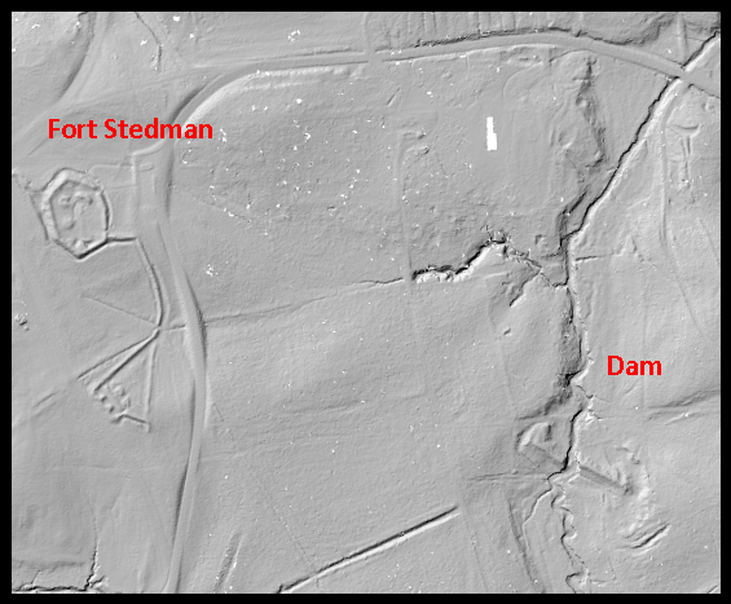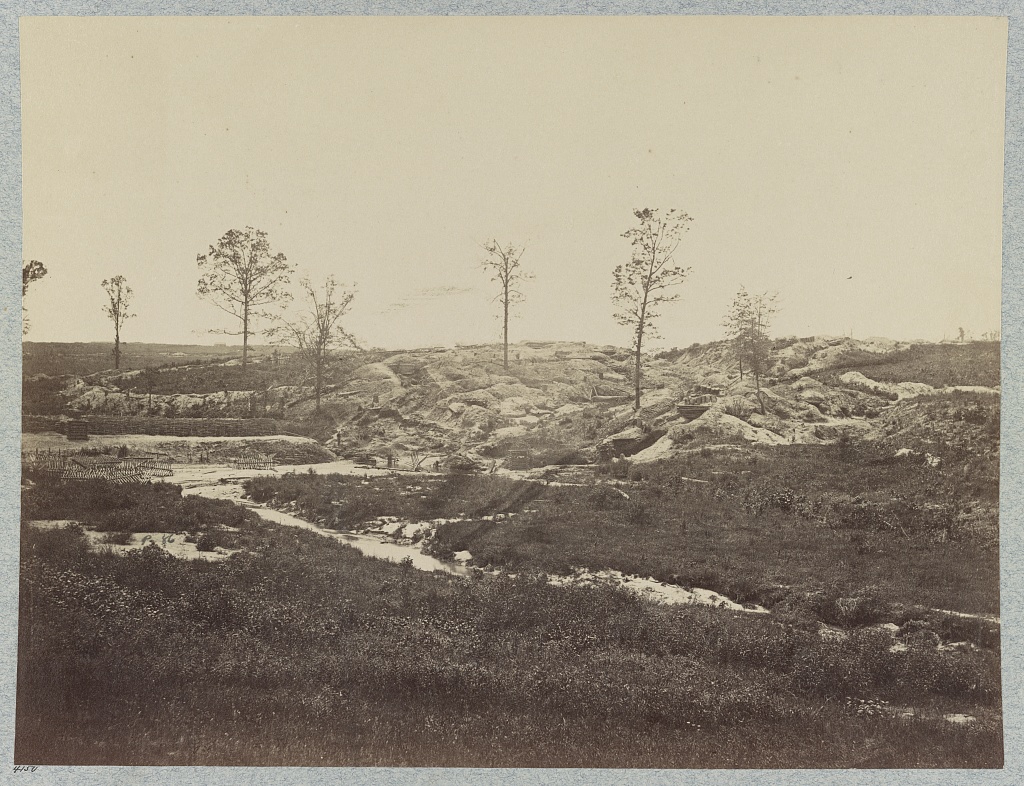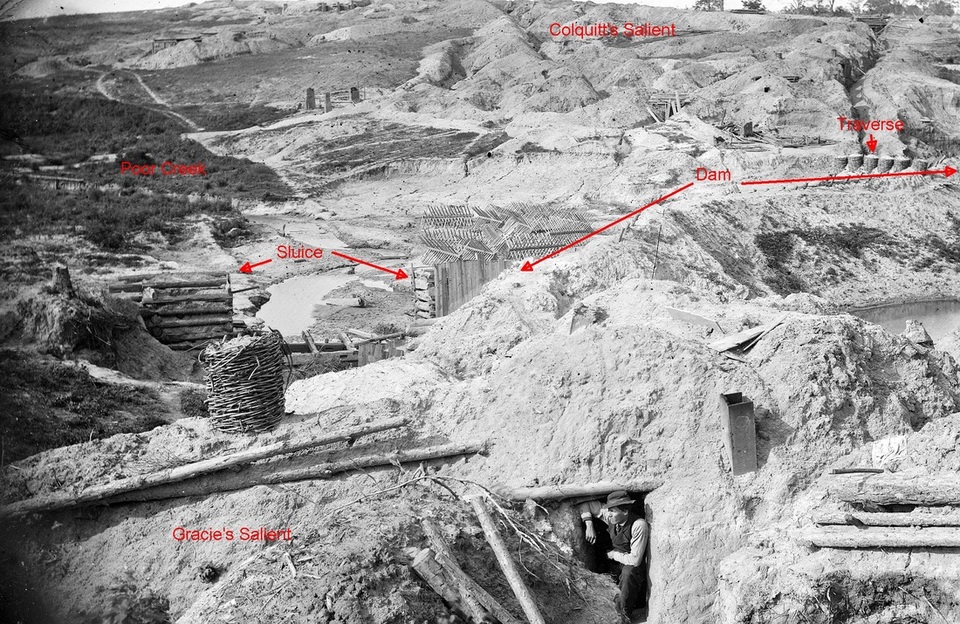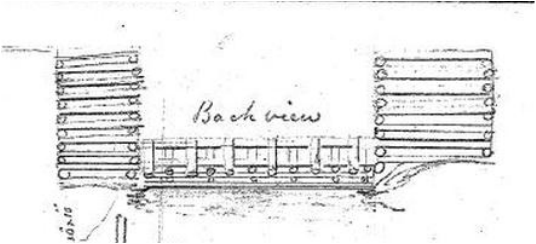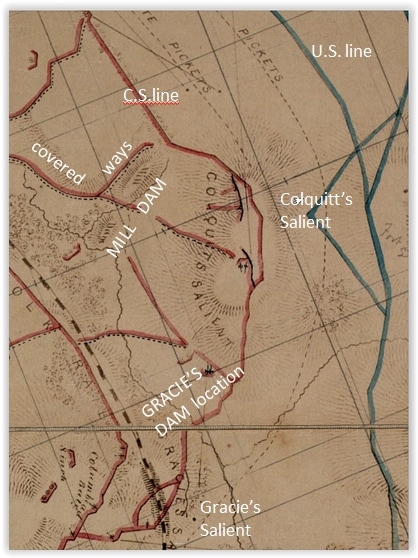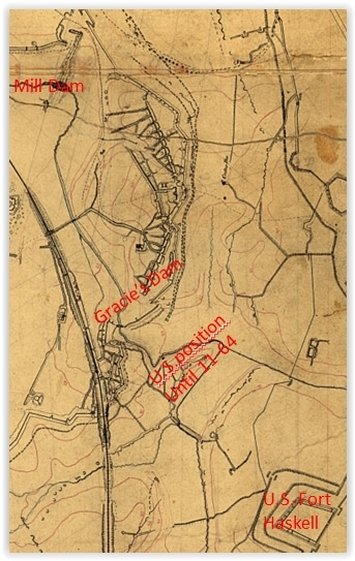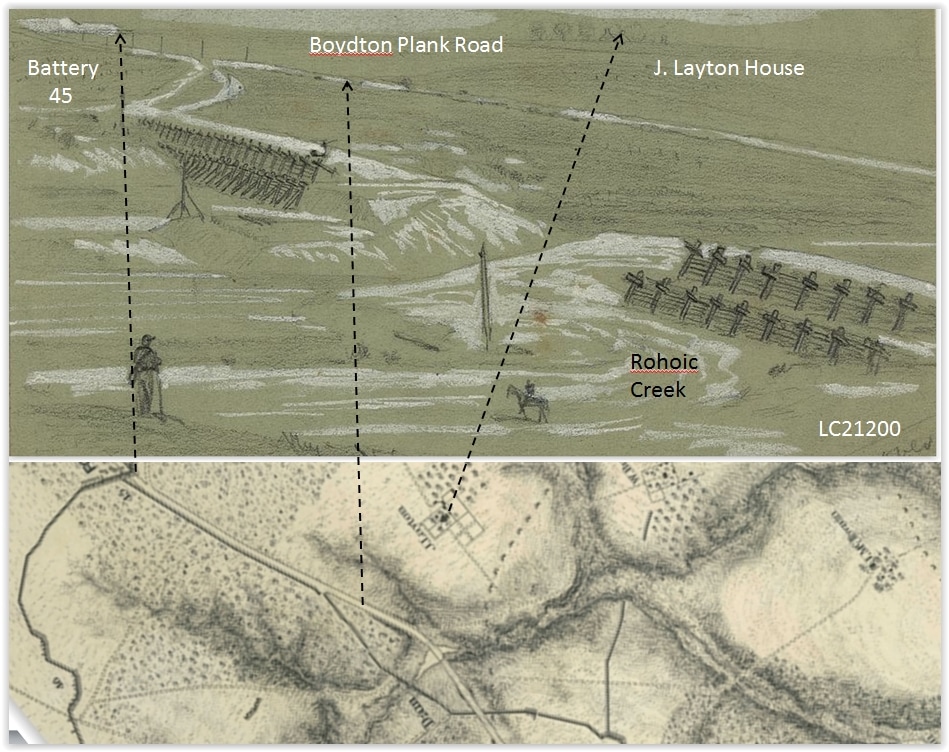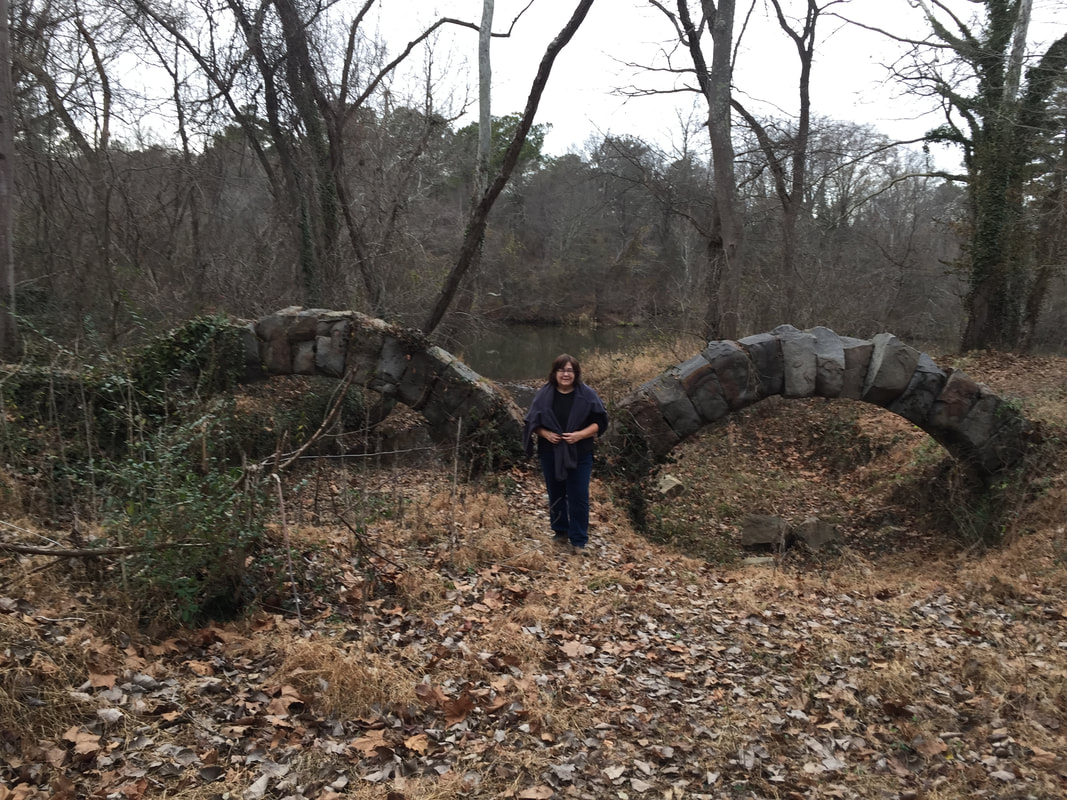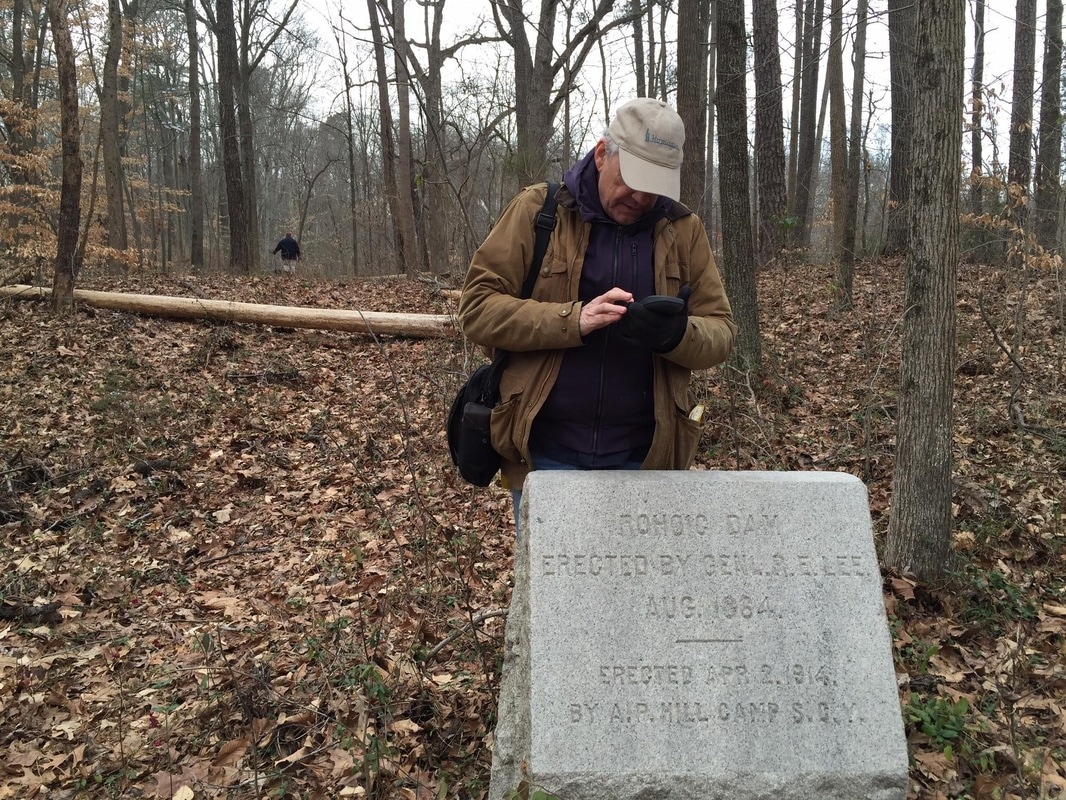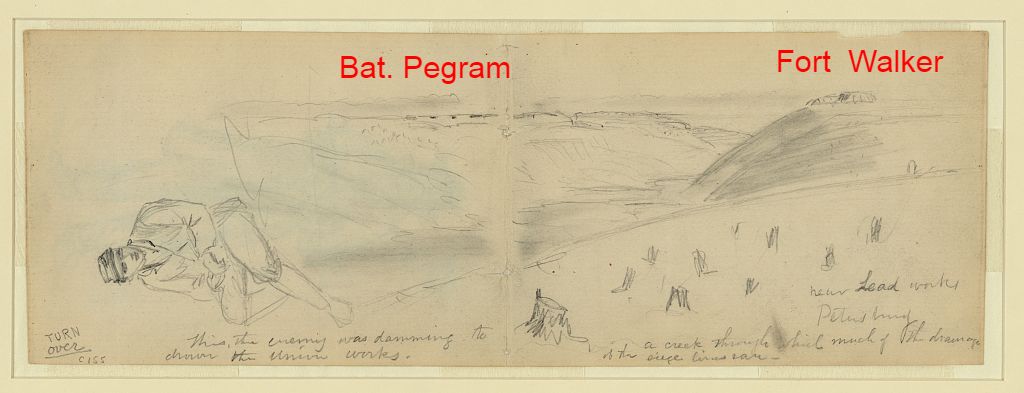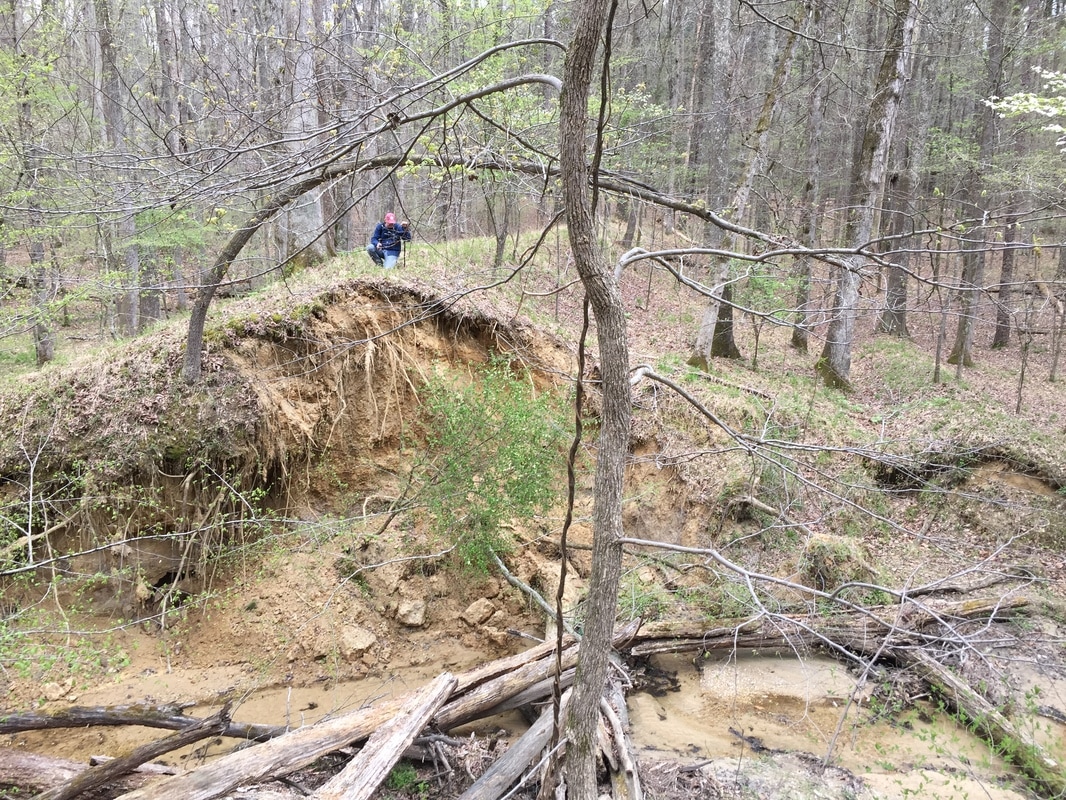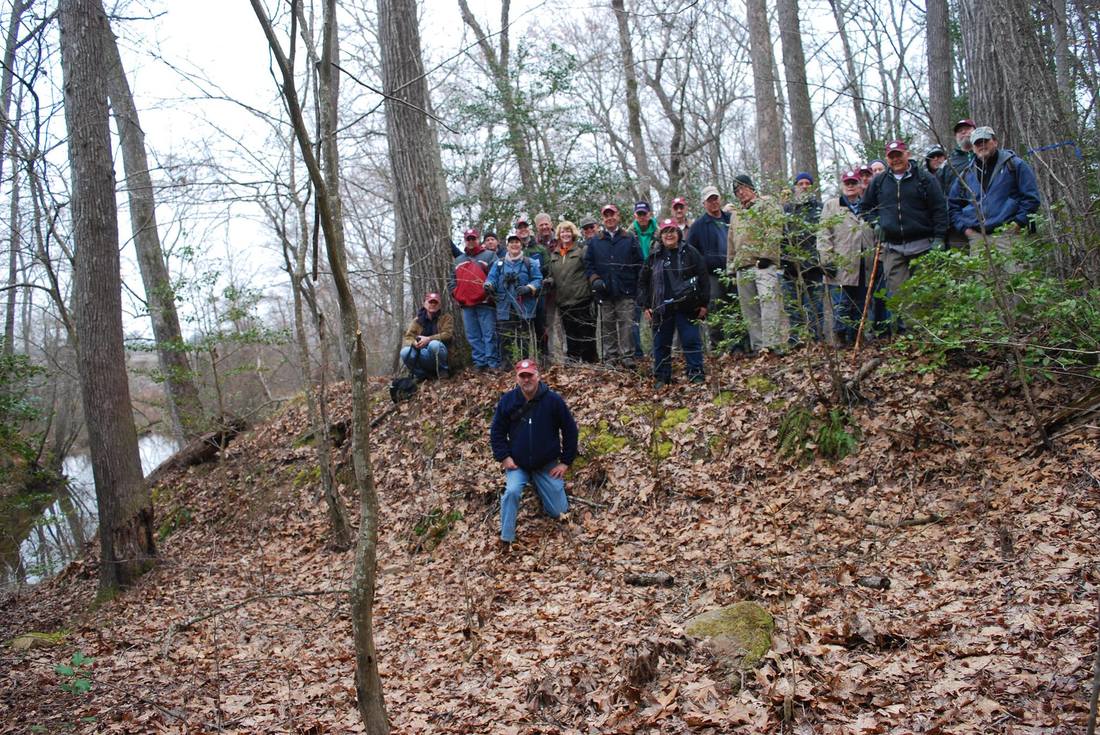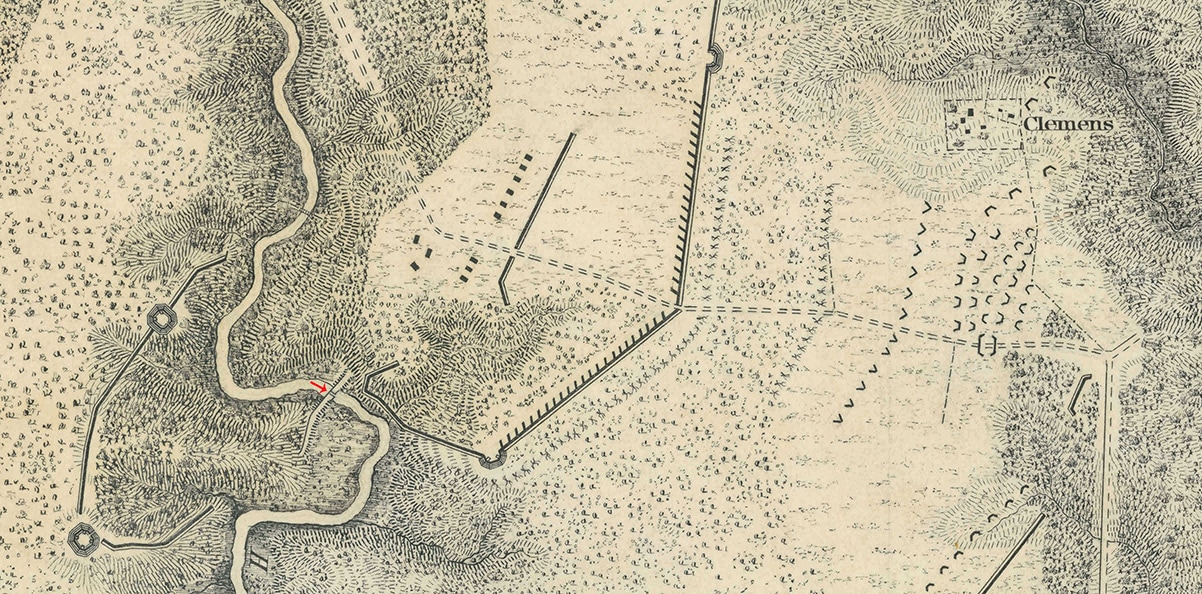Mahan's Discussion
D. H. Mahan, A Treatise on Field Fortifications, 1862, Richmond:VA.
123. Inundations. This obstacle is formed by damming back a shallow water-course, so as to make
it overflow its valley. To be effective, an inundation should be six feet deep. When this depth cannot be
procured, trous-de-loup, or else short ditches, placed in a quincunx order, are dug, and the whole
is covered with a sheet of water, which, at the ditches, must be at least six feet in depth.
124. The dams used to form an inundation are made of good binding earth. They cannot, in general,
be raised higher than ten feet; they need not be thicker than live feet at top, unless they are exposed
to a fire of artillery, in which case they should be regulated in the same way as a parapet. The
slope of the dam down-stream should be the natural slope of the earth ; but up-stream the slope
should have a base twice that of the natural slope. Sluices are made in the dams in a similar manner
to the sluices of a mill-dam, for the purpose of regulating the level of the water in the pool above, in
case of heavy rains. Water-wiers are also serviceable for the same purpose, but unless carefully made
they may endanger the safety of the dam.
125. The distance of the dams apart will depend on the slope of the stream. The level of each
pool should be at least eighteen inches below the top of the dam, and the depth of water below each
dam should be ac least six feet. These data will suffice to determine the centre line, or axis of each
dam.
126. Artificial inundations seldom admit of being turned to an effective use, owing to the difficulties
in forming them, and the ease with which they can be drained by the enemy But when it is practicable
to procure only a shallow sheet if water, it should not be neglected, as it will cause some apprehension
to the enemy. In some cases, by damming back a brook, the water may be raised to a level
sufficient to be conducted into the ditches of the work, and render some parts unassailable. The
ditches in such cases should be made very wide, and to hold about a depth of six feet. During
freezing weather the ice should be broken in the middle of the ditch, and a channel of twelve feet at
least be kept open, if practicable. The ice taken out should be piled up irregularly on each side of
the channel; and, as a farther precaution against a surprise, water should be thrown on the parapet to
freeze (pp48-49).
123. Inundations. This obstacle is formed by damming back a shallow water-course, so as to make
it overflow its valley. To be effective, an inundation should be six feet deep. When this depth cannot be
procured, trous-de-loup, or else short ditches, placed in a quincunx order, are dug, and the whole
is covered with a sheet of water, which, at the ditches, must be at least six feet in depth.
124. The dams used to form an inundation are made of good binding earth. They cannot, in general,
be raised higher than ten feet; they need not be thicker than live feet at top, unless they are exposed
to a fire of artillery, in which case they should be regulated in the same way as a parapet. The
slope of the dam down-stream should be the natural slope of the earth ; but up-stream the slope
should have a base twice that of the natural slope. Sluices are made in the dams in a similar manner
to the sluices of a mill-dam, for the purpose of regulating the level of the water in the pool above, in
case of heavy rains. Water-wiers are also serviceable for the same purpose, but unless carefully made
they may endanger the safety of the dam.
125. The distance of the dams apart will depend on the slope of the stream. The level of each
pool should be at least eighteen inches below the top of the dam, and the depth of water below each
dam should be ac least six feet. These data will suffice to determine the centre line, or axis of each
dam.
126. Artificial inundations seldom admit of being turned to an effective use, owing to the difficulties
in forming them, and the ease with which they can be drained by the enemy But when it is practicable
to procure only a shallow sheet if water, it should not be neglected, as it will cause some apprehension
to the enemy. In some cases, by damming back a brook, the water may be raised to a level
sufficient to be conducted into the ditches of the work, and render some parts unassailable. The
ditches in such cases should be made very wide, and to hold about a depth of six feet. During
freezing weather the ice should be broken in the middle of the ditch, and a channel of twelve feet at
least be kept open, if practicable. The ice taken out should be piled up irregularly on each side of
the channel; and, as a farther precaution against a surprise, water should be thrown on the parapet to
freeze (pp48-49).
Gracie's Dam
"At one place where a stream ran along our front a huge earth dam was built under the direction of the Engineer Corps, our regiment, luckily, having had nothing to do with its construction. One day, when the water had risen to the top, this dam gave way and a huge body of water came sweeping down the creek and into the Appomattox River above where we had a pontoon bridge laid. The bridge guard saw it coming but could do nothing, and it was a wonder the bridge was not carried away; but with some little damage it stood the shock. The dam was undermined by the water, the puddling ditches not having been sunk deep enough."
W.W. Blackford, War Years with Jeb Stuart, pp 270-271.
"It has been reported that the water was drawn off from the dam in the stream opposite Fort Haskell. Fearing that a demonstration might be made on that point of our line, extra vigilance was observed throughout the night. No demonstration was made and I cannot learn that any movement was made on that part of the line. I think the dam was probably carried away by the heavy rain." (OR ser. I, vol. 42, pt. 3, 1059-60.)
"Early in November, 1864, some of our men were doing picket duty in front of Fort Haskell. There was a pond in front of the fort and our picket line was between this pond and the Confederate pickets. On the night of November 5th, the enemy dammed up the outlet of this small pond, in order to raise the water over which our pickets had to pass and repass in going to and coming from their stations. They were always posted and relieved at night. There was a foot-bridge across the pond, utilized by our pickets in crossing the water. Just before midnight, three companies of the Forty-first Alabama, under command of General Gracie... captured thirty-two men on this advanced picket line, twelve of whom were from the Nineteenth. this feat was accomplished by the Alabamians without firing a gun. The next morning the water in the pond was found to be considerably above the footbridge. This affair would seem to indicate that the Confederates were fast learning "Yankee tricks." General Hancock stated on the 8th of November that the insecure picket line was due to "inattention on the part of the officers." (John Day Smith, "The History of the Nineteenth Regiment of Maine Volunteer Infantry, 1861-1865" (1909), 253-254.)
"An inspection was made on the 12th by Captain Harwood, U. S. Engineers, in reference to the destruction of a dam built by the enemy over the stream which crosses our line at Battery No. 12. A plan was submitted by Brigadier- General Egan to the commanding officer of the Second Division of the Second Corps, which was referred to me for an opinion, and upon which I submitted to-day a report to the major-general commanding this army." N. Michler, Nov. 14, 1864.
Synopsis: March 2, 1864 Grant asks Meade about a report that Lee has sent away two divisions of his army and suggests an attack, if true. Meade is skeptical, but sends his chief engineer to look into assaulting on Potter's and Willcox's (McLaughlen's) fronts. Duane reports back to Meade on the generals' plans for attacking. Potter's plan for attacking up Jerusalem Plank Road is a forerunner of what actually happens on April 2. Duane continues: "The plan of General McLaughlen is nearly the same. This column of attack is to push through the rebel line in front of Fort Haskell, and from thence to the works on the crest of Cemetery Hill. In addition to this, he proposes to destroy the dam built this winter by the enemy in front of Fort Stedman; overflow the ground in rear of the rebel left, thus cut off the retreat of that portion of the line. Both of these attacks must take place in the night, as by daylight the attacking columns would be exposed to a heavy artillery fire in front and on both flanks." ORA vol. 46, pt. 2, 785. ORA vol. 42, pt. 1, 178.
W.W. Blackford, War Years with Jeb Stuart, pp 270-271.
"It has been reported that the water was drawn off from the dam in the stream opposite Fort Haskell. Fearing that a demonstration might be made on that point of our line, extra vigilance was observed throughout the night. No demonstration was made and I cannot learn that any movement was made on that part of the line. I think the dam was probably carried away by the heavy rain." (OR ser. I, vol. 42, pt. 3, 1059-60.)
"Early in November, 1864, some of our men were doing picket duty in front of Fort Haskell. There was a pond in front of the fort and our picket line was between this pond and the Confederate pickets. On the night of November 5th, the enemy dammed up the outlet of this small pond, in order to raise the water over which our pickets had to pass and repass in going to and coming from their stations. They were always posted and relieved at night. There was a foot-bridge across the pond, utilized by our pickets in crossing the water. Just before midnight, three companies of the Forty-first Alabama, under command of General Gracie... captured thirty-two men on this advanced picket line, twelve of whom were from the Nineteenth. this feat was accomplished by the Alabamians without firing a gun. The next morning the water in the pond was found to be considerably above the footbridge. This affair would seem to indicate that the Confederates were fast learning "Yankee tricks." General Hancock stated on the 8th of November that the insecure picket line was due to "inattention on the part of the officers." (John Day Smith, "The History of the Nineteenth Regiment of Maine Volunteer Infantry, 1861-1865" (1909), 253-254.)
"An inspection was made on the 12th by Captain Harwood, U. S. Engineers, in reference to the destruction of a dam built by the enemy over the stream which crosses our line at Battery No. 12. A plan was submitted by Brigadier- General Egan to the commanding officer of the Second Division of the Second Corps, which was referred to me for an opinion, and upon which I submitted to-day a report to the major-general commanding this army." N. Michler, Nov. 14, 1864.
Synopsis: March 2, 1864 Grant asks Meade about a report that Lee has sent away two divisions of his army and suggests an attack, if true. Meade is skeptical, but sends his chief engineer to look into assaulting on Potter's and Willcox's (McLaughlen's) fronts. Duane reports back to Meade on the generals' plans for attacking. Potter's plan for attacking up Jerusalem Plank Road is a forerunner of what actually happens on April 2. Duane continues: "The plan of General McLaughlen is nearly the same. This column of attack is to push through the rebel line in front of Fort Haskell, and from thence to the works on the crest of Cemetery Hill. In addition to this, he proposes to destroy the dam built this winter by the enemy in front of Fort Stedman; overflow the ground in rear of the rebel left, thus cut off the retreat of that portion of the line. Both of these attacks must take place in the night, as by daylight the attacking columns would be exposed to a heavy artillery fire in front and on both flanks." ORA vol. 46, pt. 2, 785. ORA vol. 42, pt. 1, 178.
This photograph (LC 00522) looks northeast from the sector of the Confederate defenses known as Gracie’s Salient across the western edge of what is called Gracie’s dam towards the portion of Confederate works known as Colquitt’s Salient. The dam was part of an elaborate array of measures taken by Confederate forces to guard against attack on this portion of the front, where the opponents were close and each side had advantages and disadvantages in terms of the terrain. The earthwork that became the dam may have begun as part of the connecting line spanning Poor Creek between the two salients, but early in the siege a pond was created that formed a water obstacle. On the night of November 5- 6th, 1865, the Confederates effectively raised the water level of the pond, cut off an advanced Federal position, and captured its troops (OR XLII. Part I, 294).
We will have more to say about the offensive and defensive operations of the two forces in the Gracie’s salient part of the lines. Note "vest man" in the bombproof entrance at the bottom of the photograph.
We will have more to say about the offensive and defensive operations of the two forces in the Gracie’s salient part of the lines. Note "vest man" in the bombproof entrance at the bottom of the photograph.
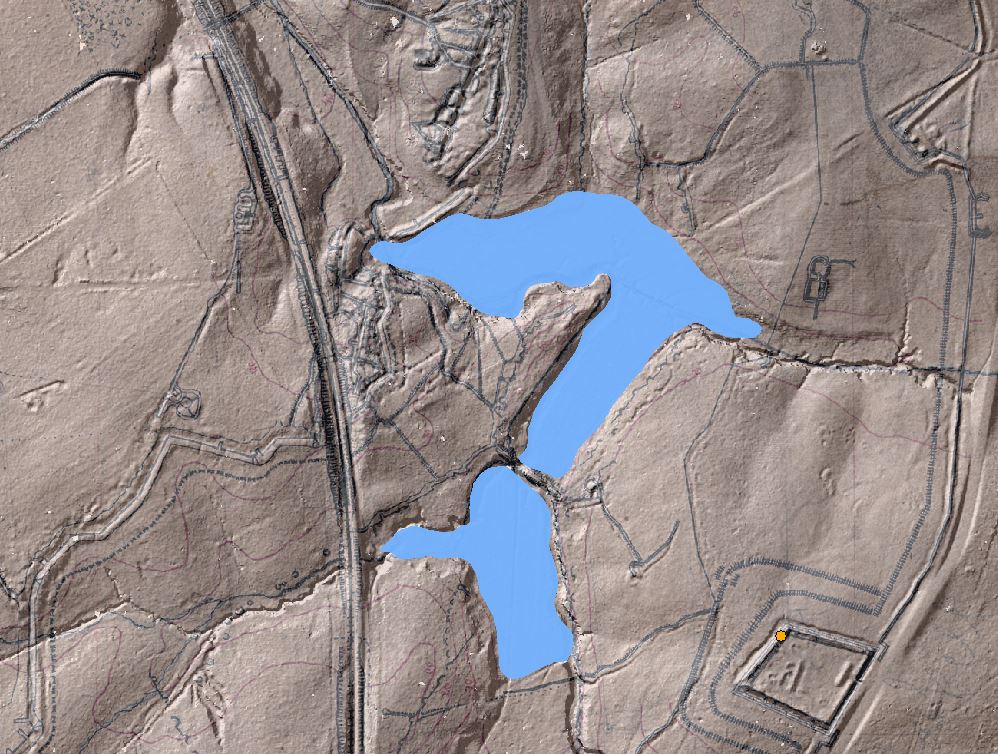
The ponds behind Gracie's Dam as projected from modern contour intervals. Gracie's dam, completed in early November, is toward the top of the map. The Union counter-dam (at the center) was built to maintain a continued presence west of Poor Creek. It may also have been used offensively to overwhelm the Confederate dam through an abrupt release of water.
Dams as earthworks
In addition to impounding water, dams, as large earthen structures, served other military purposes: they were obstacles to enemy advance and provided cover from incoming fire. Poor Creek, in the vicinity of Colquitt’s and Gracie’s salients, already had a large earthen dam, constructed before hostilities began in the area. This dam is labeled “Mill Dam” on the July,1864, map prepared by Confederate Acting Chief Engineer, W.H. Stevens, in mid-July, 1864. The dam may have been abandoned in1864, because the map does not document a mill pond or any mill buildings, nor do any other 1860s maps. Nonetheless, the massive structure was already used as cover for a Confederate supply route to Colquitt’s salient. The dam can still be seen, although it is surrounded by development. Gracie’s Dam, upstream from the Mill Dam, was constructed later in the siege, by November, 1864.
The belligerents were extremely close in this area, as we discuss elsewhere. The Confederates used everything in their arsenal to defend their besieged line- siege and field guns, mortars, mines and countermines, torpedoes, a cavalier trench behind Gracie’s salient, as well as an inundation of Poor Creek in front of Gracie’s salient. Both sides had artillery sweeping the corridor formed by the Norfolk railroad. Federal sharpshooters initially could fire down the Poor Creek valley at Gracie’s salient and enfilade Colquitt’s salient. When the federals were forced from the west side of Poor Creek in November, the dam provided both a water obstacle and cover from federal fire coming from positions east of the creek.
The belligerents were extremely close in this area, as we discuss elsewhere. The Confederates used everything in their arsenal to defend their besieged line- siege and field guns, mortars, mines and countermines, torpedoes, a cavalier trench behind Gracie’s salient, as well as an inundation of Poor Creek in front of Gracie’s salient. Both sides had artillery sweeping the corridor formed by the Norfolk railroad. Federal sharpshooters initially could fire down the Poor Creek valley at Gracie’s salient and enfilade Colquitt’s salient. When the federals were forced from the west side of Poor Creek in November, the dam provided both a water obstacle and cover from federal fire coming from positions east of the creek.
MISTOOK EACH OTHER FOR AN ENEMY.
DR. STINSON, SHERMAN, TEXAS
The Confederate Veteran
"Gracie's Alabama Brigade occupied a position in the trenches in front of Petersburg to the left of the "Crater," near where the Norfolk & Western Railroad crossed the lines. A ravine that passed through the
breastworks, and had thus been dammed up by them, became filled with water for a considerable distance and made quite a pond. Between this pond and the railroad above mentioned was a space of perhaps two hundred yards, where Confederate and Federal picket lines were very close together, in fact uncomfortably so. While on a tour of inspection along the lines one day (ien. I. ee, seeing the close proximity of the two picket lines, both being but a short distance from our main line, remarked to (Ien. Gracie, "Those fellows are too close there." Gen. Gracie construed this into an order for him to capture the line of Federal pickets. When night 'came he directed (John C.Moorhead. of the 1st Alabama Regiment, to take his company, numbering about sixty men and seven more men from the regiment and go over and capture the line at the point of the bayonet . He did not wish to bring on a general shelling, hence the order was not to fire a gun, but to effect the capture at the point of the bayonet. In Moorhead's company there were two men named Sparks and Glenn, I think mess-mates Leaping the works and approaching the enemy the boys began "taking them in" a-last as they came to them The night being very dark, and owing to the noise produced, Sparks and Glenn, above named, mistook each other for enemies, and, true to their orders, tried their bayonets on each other, and getting in too close quarters to use their guns they clinched, and took it "list and skull." In the scuffle they L'ot into the water of the pond. It occurred to Sparks, the older and stouter of the two men, that if he could get his antagonist into the water he would drown him. So, dragging Glenn out to where the water was about waist deep he " souzed " him under. By a Strong effort Glenn got his head above water and called for help. When he did this Sparks recognized his voice and said, "Why. Jim Glenn is this you?'" " Yes, by ______, it is. I reckon we had better quit, hadn't we?" Turning each other loose they went back, recovered their guns, and each captured a prisoner and came back over the works dripping wet."
Confederate Veteran
Rohoic Creek Dam
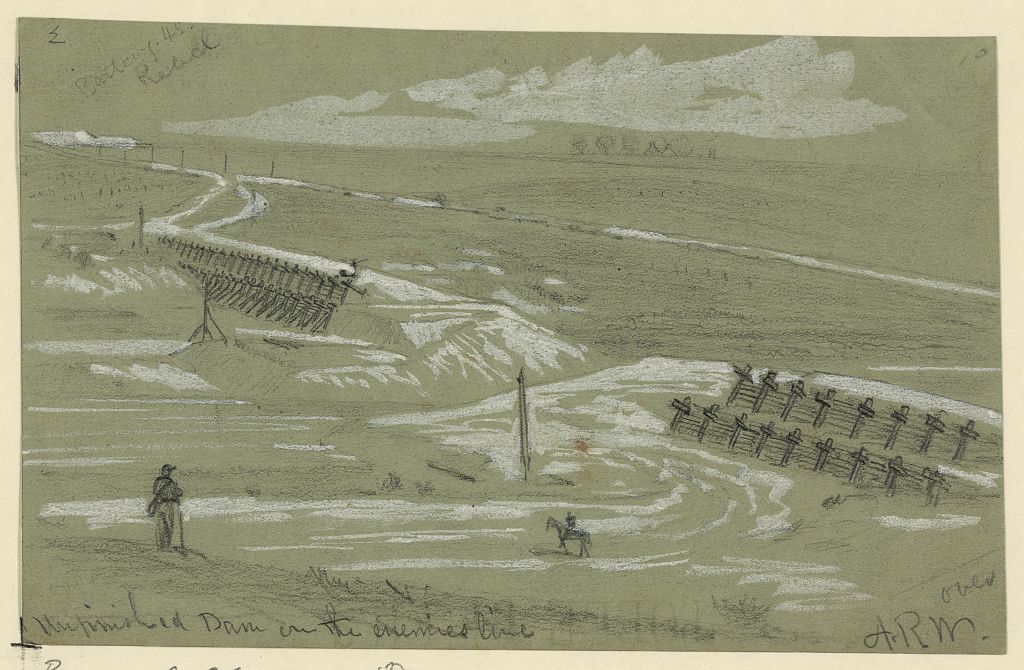 LC 21200. Unfinished dam on the enemies line, Alfred R. Waud.
Inscribed upper left: Battery 45 Rebel.
Inscribed on verso: [T]he object of this dam was to flood country in our possession and between the lines, which would have rendered a good portion of their works unapproachable. The stream is south of a very fine fort called battery 45.
LC 21200. Unfinished dam on the enemies line, Alfred R. Waud.
Inscribed upper left: Battery 45 Rebel.
Inscribed on verso: [T]he object of this dam was to flood country in our possession and between the lines, which would have rendered a good portion of their works unapproachable. The stream is south of a very fine fort called battery 45.
Alfred R. Waud’s drawing of a dam, constructed by the Confederates, across Indian Town Creek, also known as Old Town Run or Rohoic Creek, is an accurate depiction of a feature that, like most of those constructed west of the Jerusalem Plank Road, was never photographed during the war era. Waud’s caption, however, is somewhat inaccurate. The dam was not unfinished- it was completed sometime in the late fall of 1864 to serve as an obstacle in front of the Confederate lines, enabling them to man the line with fewer troops and blocking a Federal approach on the Boydton Plank Road. This major road was also guarded by batteries Gregg and 45. The Confederates put streams to good use: another artificial water barrier was constructed earlier in the siege at Gracie’s salient, where Poor Creek was dammed to create a pond between the lines. Both dams were breached by Mother Nature during heavy winter rains, but still served their purpose. The record shows that Gracie’s dam was functioning at the end of the siege, but the Indian Town Creek dam was not. Confederate engineers were urged to rebuild it in the final days of the siege (see below).
The drawing was done from the vantage point of the western side of the creek looking east toward Battery 45. It captures dam construction details, the plank road, a farm complex, and the Confederate telegraph line that sped communication along their line.
Contemporary Accounts
General Lee had an immense dam constructed across a creek that ran between Battery 45 and Fort Gregg on the opposite hill, there being nothing between the two forts. Our men were called on to work on the dam and in a mine near out camp. About Christmas the dam was completed and the waters stopped, but the dam did not fill for two weeks, but when it did fill it was the largest body of fresh water I ever saw and completely [filled] the line between the two forts. Then came a hard rain during the latter part of the winter which broke the dam and tore up everything below, smashing the railroad bridge and the stone viaducts of the canal and almost stopped the Appomattox so that all our hard work went for nothing.
Clark, Walter. Histories of the Several Regiments and Battalions from North Carolina in the Great War 1861-’65, Volume 4 (Nash Brothers: 1901); p.204.
"Camp, detachment Eng.
Troops, A.N.V.
January 29th, 1865
Dear Henry
…The heavy rains that have fallen since you were here, have damaged the military works about here considerably….That large dam, the pond of which formed part of our Line in front of Battery 45 gave way, precipitating the vast collection of water above on to the country below. Trees were torn up by the roots and in the passage to the Appomattox, it swept away the aqueduct to the canal and of that portion of the South-side R.R. that lay across its track. So powerful was the force of the water that it swept a number of blocks of stone from the aqueduct clear across the swollen Appomattox landing them on the opposite shore- a distance of several hundred yards. Those who saw the flood as it rushed down the river say the wall (Red sea like) was several ft. high. One of the pontoons below was somewhat injured by it. Three of the men of the Regt. who happened to be out in a boat on the river at the time, were drowned."
Rebel Brothers: The Civil War Letters of the Truehearts. Edited by Edward B. Williams. 1995
"An incident worthy of record occurred in the winter of 1864-’65, while the Twenty-second North Carolina was on duty on the lines south of Petersburg, Va., in support of Battery 45. General A. P. Hill, commanding the [Third] corps, was desirous of getting certain information with regard to the force and position of the enemy on his front. This he thought might be obtained by the capture of some prisoners, and he directed General A. M. Scales, commanding brigade, to make a foray on the skirmish line or picket posts of the enemy opposite his lines. General Scales detailed Captain C. Frank Siler, of Company M, of the Twenty-second North Carolina, to undertake the expedition with a part of the sharpshooters of the brigade. Captain Young, who commanded the sharpshooters, was temporarily absent. Siler was ordered to report to General James H. Lane and get a reinforcement from the sharpshooters of that brigade, but before making the move, Siler wished to reconnoitre the position. To effect this thoroughly, he adopted a ruse. Crossing to the Yankee lines he offered, with the usual signals, to exchange newspapers, as was often done. While haggling about the exchange he examined the position and its surroundings carefully and selected a path by which it might be approached advantageously, returning to his command, he rode over to General Lane’s quarters to get the reinforcements as ordered, General Scales having loaned him a horse for the purpose. Now, for the better defence of Battery 45, the men of the Twenty-second had dammed up a small stream in its vicinity which had the effect of collecting much water in the battery’s front and rendering the approach to it very difficult. Along the top of this dam was the shortest route between the two brigades, and over it Siler attempted to ride. It was very dark, however, and, as he afterwards discovered, his horse was “moon-eyed,” and in consequence, horse and man tumbled off the dam into the water and mud seventeen feet below. Nothing daunted, and in spite of cold and bruises, he fished himself and horse out, and after much tribulation he succeeded, “accoutred as he was,” in finding Major Wooten, who commanded Lane’s sharpshooters, and got the detail wanted. Uniting them with his own men they all proceeded quietly to the Yankee rifle pits by the path Siler had previously selected. Arrived at the pits, they found all there asleep except a sentinel in front of the works, upon whom they closed before he could discharge his piece. The sentry ran into the works and tried to use his bayonet, but Siler turned it aside and secured him before he could give the alarm. The command then swept up and down the rifle pits, and after capturing sixty men, made good their retreat with their prisoners, to the Confederate lines, not, however, without receiving a heavy fire from the Yankees, who had recovered from their surprise, which, owing to the darkness, fortunately, did no damage. From some of the prisoners captured all information wanted was obtained, and Captain Siler and his men were highly complimented for their gallant action."
Clark, Walter. Histories of the Several Regiments and Battalions from North Carolina in the Great War 1861-’65, Volume 2 (Nash Brothers: 1901), pp. 178-180.
To economize men and shorten the line of his defense, Gen. Lee constructed a huge dam across Run, two miles west of Petersburg, on the Boydton plank road, just below the confluence of two branches which came together from opposite directions, and which ran along immediately in front of the Confederate lines. These branches rippled in perpetual flow down the sharp valleys between prominent hills. The dam was some 300 feet long, fifty feet high, 100 feet thick at the base and thirty feet at the top. When filled, the water covered the valleys to a depth of from five to thirty feet for more than half a mile on either side of the dam ; and was an effectual bar to Federal attack for that distance. Hence no troops were needed on this part of our line while the dam lasted. The weight of water which collected above the dam, and lay against the un- settled earth heavily, eventually broke the dam with a disastrous flood, which swept the valley of coons and cabins out into the roaring Appomattox ; and the lines thus vacated had again to be manned with troops(pages 219-220).
Dunlop, Major W. C., Lee's Sharpshooters; or, the Forefront of Battle. 1899.
Dunlop, Major W. C., Lee's Sharpshooters; or, the Forefront of Battle. 1899.
HDQRS. ARTILLERY, ARMY OF NORTHERN VIRGINIA, March 23, 1865.
Lieutenant Colonel C. M. BRAXTON,
Commanding Artillery Battalion:
COLONEL: I have written a note to Captain Green instructing him to remain and aid you about foraging your animals until Monday next, when it will be best for him I think to repair to the battalion intended for Lieutenant-Colonel King, north of James River near General Alexander's. I informed General Walker's adjutant this morning that you were to have the two U. S. 3-inch rifles which Chew has had. They are in Battery Gregg near the broken dam southwest of Petersburg. You had best get them at once. Let me know how many horses you need that I may order them for you. I do not think it expedient just now while you are making arrangements for efficiency that either of your companies should be put on the lines. It is better I think that Colonel Pegram's company, now back from the line, be placed on it for a season than that you should be obstructed in your preparations. I direct your messenger to show this note at General Walker's headquarters, that the requisite instructions to this effect may be there issued.
Respectfully, your obedient servant,
W. N. PENDLETON,
Brigadier-General and Chief of Artillery.
OR XLVI, III: 1337.
Lieutenant Run- Dammed or Not?
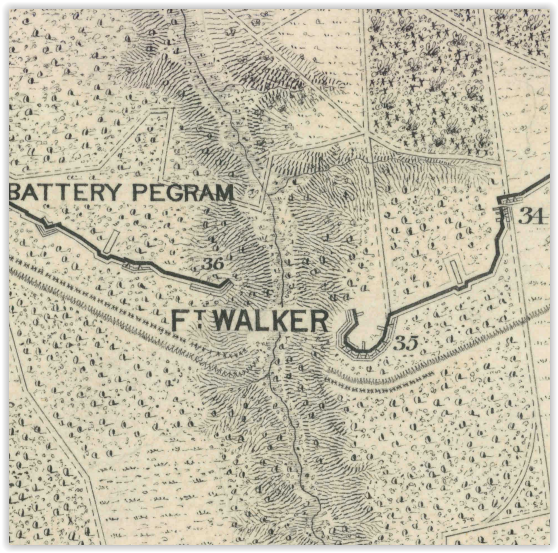
The drawing above seems to be the valley of a branch of Lieutenant Run between Battery Pegram and Fort Walker. Waud's comment that this dam was envisioned to drown a portion of the Union lines is overly ambitious- the lines are quite far apart in this sector, but the dam could have provided a serious water obstacle to Federal approaches. The post war Michler map to the right does not show a dam, or a partially constructed dam. The creek is dammed today and forms Wilcox Lake.
Harrison's Creek Dam
The incident described below could refer to this dam:
August 15, 1864, Flood
Captain Baggs, then in command of the Third Battalion of the Second Pennsylvania Heavy Artillery, moved his command to the Ninth Corps front on the I4th of August, taking position just in rear of the "crater mine," which was almost as hot a position as it formerly held near the City Point Railroad. On the 15th of August, during a heavy rainstorm, a dam at the breastworks, some distance up the ravine in which the regiment had its camp, gave way, causing a rapid rise in the stream and not only washed away all the camp's equipage, but caused the drowning of some two hundred soldiers who were camped some distance further up the ravine and were caught in the sudden rise of the water, mostly of whom were colored troops. Many were seen floating down the current on logs, but were unable to make shore, and were carried to the railroad bridge, where, striking the stone abutments, would become entangled in the jam of logs there and be either killed or drowned.
Lieutenant Colonel Benjamin F. Winger, in a letter, referred to the flood and his experiences as follows :. "A funny, yet sad thing occurred at the time of a big Virginia flood in, the ravine in the rear of Fort Steadman, in 1864, where we had our main headquarters. Several sutlers tents were in this ravine, and their whole stock was flooded down the stream towards the Appomattox. A number of cases of champagne were seen swimming along, and an old sailor jumped in and got a case. An old soldier seeing it, also jumped in, and attempted to capture two cases, but failed, for, although a good swimmer, the swift current of the waters carried him down to the railroad bridge, where, being caught and fastened in the debris, he was drowned (p.96).
George W.Ward , History of the Second Pennsylvania Heavy Artillery (112th Regiment Pennsylvania Volunteers), from 1861-1866, Including the Provisional Second Penn'a Heavy Artillery. 1904.
August 15, 1864, Flood
Captain Baggs, then in command of the Third Battalion of the Second Pennsylvania Heavy Artillery, moved his command to the Ninth Corps front on the I4th of August, taking position just in rear of the "crater mine," which was almost as hot a position as it formerly held near the City Point Railroad. On the 15th of August, during a heavy rainstorm, a dam at the breastworks, some distance up the ravine in which the regiment had its camp, gave way, causing a rapid rise in the stream and not only washed away all the camp's equipage, but caused the drowning of some two hundred soldiers who were camped some distance further up the ravine and were caught in the sudden rise of the water, mostly of whom were colored troops. Many were seen floating down the current on logs, but were unable to make shore, and were carried to the railroad bridge, where, striking the stone abutments, would become entangled in the jam of logs there and be either killed or drowned.
Lieutenant Colonel Benjamin F. Winger, in a letter, referred to the flood and his experiences as follows :. "A funny, yet sad thing occurred at the time of a big Virginia flood in, the ravine in the rear of Fort Steadman, in 1864, where we had our main headquarters. Several sutlers tents were in this ravine, and their whole stock was flooded down the stream towards the Appomattox. A number of cases of champagne were seen swimming along, and an old sailor jumped in and got a case. An old soldier seeing it, also jumped in, and attempted to capture two cases, but failed, for, although a good swimmer, the swift current of the waters carried him down to the railroad bridge, where, being caught and fastened in the debris, he was drowned (p.96).
George W.Ward , History of the Second Pennsylvania Heavy Artillery (112th Regiment Pennsylvania Volunteers), from 1861-1866, Including the Provisional Second Penn'a Heavy Artillery. 1904.
An additional account:
15 Aug., *64. The great shower, so disastrous in some parts of the line, occurred while the 23rd was in the front line. Here they suffered no greater harm than a thorough wetting, which, however, was more endurable in the open than in the bomb-proofs whose leaky roofs streaked them with yellow mud. The rain, moreover, filled the excavations, turning bomb-proofs to cisterns and zigzags to canals, thereby giving those who must move from place to place the choice whether to be drowned or shot. In one place, our boys got some satisfaction by helping the accumulated waters cut a new passage through a low place in the works and pour out upon the rebels, who, just there, occupied lower ground. In the camp, or, more particularly, in the ravine in front of it, the damage was much greater. The protection afforded by the high, steep sides of the ravine from the direct fire of the enemy, was very enticing. Some regiments and some sutlers, failing to notice the marks of former freshets, or, lightly discounting the risks, had pitched their camps, mostly shelter-tents, and established their shops. Over most of these, shelters from the sun, made of green boughs laid on frames of poles, had been raised. Even towards the hill-top, where the 23rd had its little camp, the rain was heavy enough to wash away all lighter articles and present to the men returning that night from their tour of duty in the " pits " a scene of wild confu- sion. He was lucky who could find even one corner of his shelter-tent still in sight and could thus rescue it from the overwhelming mud. In the ravine, the water running from all the neighboring heights soon became a raging torrent. It swept away camps and shops like straws in a gutter. It rolled army wagons over and over before it. It swept away a section of the railroad bridge. Men, caught sleeping in their tents or hampered by the fall of the leafy shades, were helpless. Nor could those on the bank render much aid, for the torrent carried their luckless comrades away as fast as they could run along to their rescue. Some, who, after the first rush of the angry waters, ventured in to " save" the coveted goods of unlucky sutlers, found themselves in a dilemma which was not without its danger. The current was still strong enough to make it impossible to climb the steep clay banks without help. Some accounts assert a loss of 40 men. I do not learn that this included any one from the 23rd. It is said that a man, with difficulty saved from very imminent death by drowning, was immediately killed by a stray rebel bullet piercing his brain (227-228).
James A. Emmerton. A Record of the Twenty-third Regiment Mass. Vol. Infantry in the War of the Rebellion 1861-1865. 1886.cord of the Twenty-third Regiment Mass. Vol. Infantry in the War of the Rebellion 1861-1865
